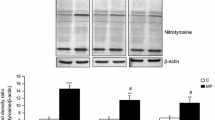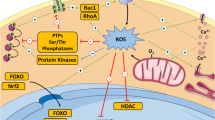Abstract
Both H2O2 (IC50=70 μM) and HOCl (IC50=8.5 μM) inhibited mitogen-induced MNL proliferation in a dose-dependent manner. This was found to be due to a depletion of intracellular ATP by at least two distinct mechanisms. HOCl and high concentrations (>100 μM) of H2O2 inhibit ATP generation via sulfhydryl group oxidation on the active site of the glyceraldehyde-3-phosphate dehydrogenase (G3PDH) enzyme of the glycolytic pathway. On the other hand, low H2O2 concentrations cause ATP depletion by an activation of the DNA repair enzyme, poly(ADP-ribose)polymerase (pADPRP), leading to consumption of NAD+, an essential cofactor for G3PDH. The anti-oxidants ascorbate and cysteine protected MNL against the anti-proliferative effects of HOCl. Similar results were achieved with the HOCl-mediated inhibition of ATP production and G3PDH activity. However, ascorbate was unable to protect against H2O2-mediated inhibition of MNL functions, while cysteine protected against the inhibitory effects on ATP production and G3PDH activity, induced by this oxidant.
Similar content being viewed by others
References
S. T. Test and S. J. Weiss,Quantitative and temporal characterization of the extracellular H 2 O 2 pool generated by human neutrophils. J. Biol. Chem.259, 399–405 (1984).
S. J. Weiss,Oxygen, ischemia and inflammation. Acta Physiol. Scand.548, 9–37 (1986).
S. J. Weiss and A. F. LoBuglio,Biology of disease: Phagocyte-generated oxygen metabolites and cellular injury. Lab. Invest.47, 5–18 (1982).
C. C. Winterbourn,Comparative reactivities of various biological compounds with myeloperoxidase-hydrogen-peroxide-chloride, and similarity of the oxidant to hypochlorite. Biochim. Biophys. Acta840, 204–210 (1985).
M. J. Smit and R. Anderson,Inhibition of mitogen-activated proliferation of human lymphocytes by hypochlorous acid in vitro: Protection and reversal by ascorbate and cysteine. Agents and Actions30, 338–343 (1990).
R. Anderson,Ascorbate-mediated stimulation of neutrophil motility and lymphocyte transformation by inhibition of the peroxidase/H 2 O 2 /halide system in vitro and in vivo. Am. J. Clin. Nutri.34, 1906–1911 (1981).
A. El-Hag and R. A. Clark,Immunosuppression by activated human neutrophils. Dependence on the myeloperoxidase system. J. Immunol139, 2406–2413 (1987).
D. C. Zoschke and N. D. Staite,Suppression of human lymphocyte proliferation by activated neutrophils or H 2 O 2:Surviving cells have an altered T-helper/T-suppressor ratio and an increased resistance to secondary oxidant exposure. Clin. Immunol. Immunopathol.42, 160–170 (1987).
P. A. Hyslop, D. B. Hinshaw, W. A. Halsey, I. U. Schraufstätter, R. D. Sauerheber, R. G. Spragg, J. H. Jackson and C. G. Cochrane,Mechanisms of oxidant-mediated cell injury: The glycolytic and mitochondrial pathways of ADP phosphorylation are major intracellular targets inactivated by hydrogen peroxide. J. Biol. Chem.263, 1665–1675 (1988).
I. U. Schraufstätter, D. B. Hinshaw, P. A. Hyslop, R. G. Spragg and C. G. Cochrane,Oxidant injury of cells. DNA strand breaks activate polyadenosine diphosphate-ribose polymerase and lead to depletion of nicotinamide adenine dinucleotide. J. Clin. Invest.77, 1312–1320 (1986).
M. S. Baker, J. Feigan and D. A. Lowther,The mechanism of chondrocyte hydrogen peroxide damage. Depletion of intracellular ATP due to suppression of glycolysis caused by oxidation of glyceraldehyde-3-phosphate dehydrogenase. J. Rheumatol.16, 7–14 (1989).
I. U. Schraufstätter, K. Browns, A. Harris, P. A. Hyslop, J. H. Jackson, O. Quehenberger and C. G. Cochrane,Mechanisms of hypochlorite injury of target cells. J. Clin. Invest.85, 554–562 (1990).
F. Dallegri, R. Goretti, A. Ballestero, L. Ottonello and F. Patrone,Neutrophil-induced depletion of adenosine triphosphate in target cells: Evidence for hypochlorous acid-mediated process. J. Lab. Clin. Med.112, 765–772 (1988).
A. Böyum,Isolation of leucocytes from human blood. Further observations: Methylcellulose, destran, and ficoll as erythrocyte aggregating agents. Scand. J. Lab. Invest.21, 31–50 (1968).
N. Borregaard and A. I. Tauber,Subcellular localization of the human neutrophil NADPH oxidase b-Cytochrome and associated flavoprotein. J. Biol. Chem.259, 47–52 (1984).
G. L. Ellman,Tissue sulphydryl groups. Arch. Biochem. Biophys.82, 70–77 (1959).
F. Noll, InMethods of Enzymatic Analysis, 2nd Ed. (Ed. H. U. Bergmeyer) p. 1475, Academic Press Inc., New York 1974.
H. Holmsen, E. Storm and H. J. Day,Determination of ATP and ADP in blood platelets: A modification of the firefly luciferase assay for plasma. Anal. Biochem.46, 489–501 (1972).
W. Cantrow and B. D. Stollar,The use of bacterial luciferase and liquid scintillation spectrometer to assay the enzymatic synthesis of NAD +. Anal. Biochem.71, 333–340 (1976).
E. Beutler, Red Cell Metabolism. A Manual of Biochemical Methods. Grune & Stratton, New York 1975.
D. A. Carson, S. Seto, D. B. Wasson and C. J. Carrera,DNA strand breaks, NAD metabolism, and programmed cell death. Exp. Cell. Res.164, 273–281 (1986).
S. M. Sepe and R. A. Clark,Oxidant membrane injury by the neutrophil myeloperoxidase system. II. Injury by stimulated neutrophils and protection by lipid soluble antioxidants. J. Immunol.134, 1896–1901 (1985).
R. Anderson, M. J. Smit, G. K. Jooné and A. M. Van Staden,Vitamin C and cellular immune functions: Protection against hypochlorous acid-mediated inactivation of glyceraldehyde-3-phosphate dehydrogenase and ATP generation in human leukocytes as a possible mechanism of ascorbate-mediated immlunostimulation. Ann. NY. Acad. Sci.587, 34–48 (1990).
C. Little and P. J. O'Brien,Mechanism of peroxide-inactivation of sulfhydryl enzyme glyceraldehyde-3-phosphate dehydrogenase. Eur. J. Biochem.10, 523–538 (1969).
J. H. Jackson, E. Gajewski, I. U. Schraufstätter, P. A. Hyslop, A. F. Fuciarelli, C. G. Cochrane and M. Dizdaroglu,Damage to the bases in DNA induced by stimulated human neutrophils. J. Clin. Invest.84, 1644–1649 (1989).
O. I. Auroma, B. Halliwell and M. Dizdaroglu,Iron-dependent modification of bases in DNA by the superoxide radical-generating system hypoxanthine/xanthine oxidase. J. Biol. Chem.264, 1324–1328 (1989).
B. Frei, L. England and B. N. Ames,Ascorbate is an outstanding antioxidant in human blood plasma. Proc. Natl. Acad. Sci. USA.86, 6377–6381 (1989).
Author information
Authors and Affiliations
Rights and permissions
About this article
Cite this article
Smit, M.J., Anderson, R. Biochemical mechanisms of hydrogen peroxide- and hypochlorous acid-mediated inhibition of human mononuclear leukocyte functionsin vitro: Protection and reversal by anti-oxidants. Agents and Actions 36, 58–65 (1992). https://doi.org/10.1007/BF01991229
Received:
Accepted:
Issue Date:
DOI: https://doi.org/10.1007/BF01991229




